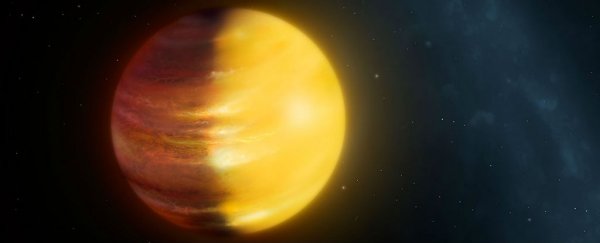For the first time, scientists have detected long-term weather systems on a gigantic gas planet outside the Solar System, and say the clouds and violent winds that envelop this distant world appear to be made from corundum minerals - the building block of rubies and sapphires.
That might sound pretty, but with daytime temperatures reaching highs of 2,500℃, the minerals that give gemstones their colours here on Earth would be completely vaporised before streaming through the atmosphere.
"It's a hellhole," one of the researchers, David Armstrong from the University of Warwick, told Kate Lunau at Motherboard.
The winds themselves could have a certain hue, he adds, but until we know more about the planet's composition, what colour that would be is anyone's guess.
"It depends on what else is in the atmosphere," says Armstrong. "We don't know the colour, but it would certainly be stunning."
The planet in question, called HAT-P-7b, is more than 1,000 light-years from Earth and 500 times more massive.
Located in the constellation Cygnus, the planet is known as a 'hot Jupiter' - a subclass of gas giants that are similar in size, mass, and composition to Jupiter, but they orbit so close to their parent star, they harbour some insane surface temperatures.
Late last year, a weather map was made of a similar hot Jupiter planet - HD 189733b, located 63 light-years away in the constellation Vulpecula.
But now scientists have been able to observe four years' worth of weather systems on HAT-P-7b, giving us the most detailed look yet at conditions on distant planets.
"With this four-year timeline, you can really start to look in depth at these planets," Hannah Wakeford from NASA's Goddard Space Flight Centre, who was not involved in the study, told New Scientist.
"Our full understanding of these planets and the clouds in their atmospheres is just beginning."
The team has come up with the two most likely candidates for what these clouds are made from: corundum, a crystalline form of aluminium oxide that makes rubies and sapphires; and perovskite, a calcium titanium oxide mineral used to make solar cells.
But corundum looks like the best bet so far.
"[T]here is sufficient available material to form an optically thick cloud for corundum, but less so for perovskite, mainly because Al [aluminium] is more abundant than Ti [titanium]," the team concludes.
"As there are a number of assumptions here, this does not exclude perovskite, but makes corundum the more likely of the two."
By analysing data from NASA's Kepler space telescope, the researchers could monitor variations in light intensity as the planet orbits its parent star to get an idea of its weather conditions.
They observed significant changes in brightness and heat, with the planet's brightest point shifting its location throughout the day - sometimes the brightest point was located on the 'morning side' of the planet that faces its star, and sometimes it would be on the planet's 'afternoon side'.
Just like our Moon, HD 189733b is tidally locked, meaning the same side always faces its star, and the other side is always facing away.
Armstrong thinks that this shifting in the brightest point is because of thick cloud cover being pulled around the scorching hot planet by an equatorial jet of wind travelling at several kilometres per second.
So thanks to the planet having one cool side and one hot side, the clouds would likely condense on the cool side, and the temperature difference would create fast-moving winds that usher them over to the hot side to be evaporated.
"These results show that strong winds circle the planet, transporting clouds from the night side to the dayside," Armstrong says in a press release. "The winds change speed dramatically, leading to huge cloud formations building up then dying away."
The team plans on continuing its investigation of HD 189733b's weather patterns, so hopefully we'll get a better idea of what clouds of vaporised ruby minerals actually look like, because it sounds cool as hell.
The study has been published in Nature Astronomy.
